

Niche. Look around your community.

It is filled with people doing lots of different jobs. Farmers grow food, carpenters build houses, doctors keep us healthy, and teachers help us learn. These people and many others make a human community work. The natural world is filled with plants and animals, each with their own special job or niche. A niche is the role played by an organism in the natural world. Some animals, like the pileated woodpecker, are insect eaters. Other animals like pinyon jays, red squirrels, and chipmunks are spreaders. The blackberry bush and other plants serve as food for animals. Animals and plants all have very special roles to play in their communities.
How and Why Animals Migrate. Reasons to Move Some animals travel relatively short distances to find food or more favorable living or breeding conditions.Most animals that migrate do so to find food or more livable conditions.
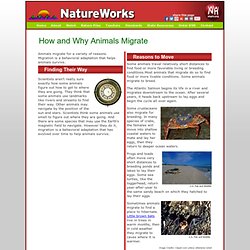
Some animals migrate to breed. The Atlantic Salmon begins its life in a river and migrates downstream to the ocean. After several years, it heads back upstream to lay eggs and begin the cycle all over again. Some crustaceans also migrate for breeding. Frogs and toads often move very short distances to breeding ponds and lakes to lay their eggs. Sometimes animals migrate to find a place to hibernate. Image Credits: Clipart.com unless otherwise noted. NCEA Animal rhythms and actograms. Chemical Communication. Do I Know You?
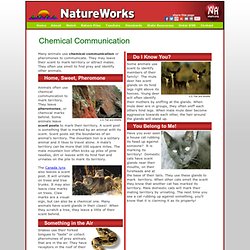
Some animals use scent to identify members of their family! The mule deer has scent glands on its hind legs right above its hooves. Young deer will often identify their mothers by sniffing at the glands. When mule deer are in groups, they often sniff each others hind legs. When male mule deer become aggressive towards each other, the hair around the glands will stand up.
You Belong to Me! Have you ever seen a house cat rubbing its head up against someone? Image Credits: Clipart.com unless otherwise noted. Tropisms. A tropism is a growth movement whose direction is determined by the direction from which the stimulus strikes the plant.
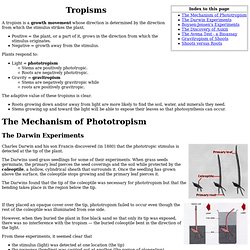
Positive = the plant, or a part of it, grows in the direction from which the stimulus originates. Negative = growth away from the stimulus. Plants respond to: Light = phototropismStems are positively phototropic. Roots are negatively phototropic.Gravity = gravitropismStems are negatively gravitropic while roots are positively gravitropic. Auxins. History of Auxins and Pioneering Experiments Auxins were the first plant hormones discovered.
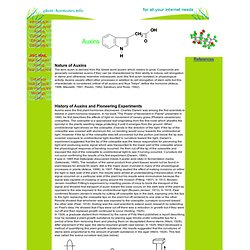
Charles Darwin was among the first scientists to dabble in plant hormone research. In his book "The Power of Movement in Plants" presented in 1880, he first describes the effects of light on movement of canary grass (Phalaris canariensis) coleoptiles. The coleoptile is a specialized leaf originating from the first node which sheaths the epicotyl in the plants seedling stage protecting it until it emerges from the ground. When unidirectional light shines on the coleoptile, it bends in the direction of the light. If the tip of the coleoptile was covered with aluminum foil, no bending would occur towards the unidirectional light. Much of our current knowledge of auxin was obtained from its applications. Biosynthesis and Metabolism of Auxin IAA is chemically similar to the amino acid tryptophan which is generally accepted to be the molecule from which IAA is derived.
Rhythms. Pheromones. Pheromones are chemicals released by an organism into its environment enabling it to communicate with other members of its own species.
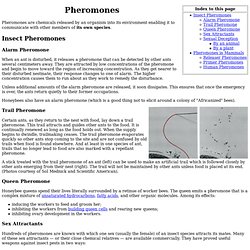
Insect Pheromones Alarm Pheromone When an ant is disturbed, it releases a pheromone that can be detected by other ants several centimeters away. They are attracted by low concentrations of the pheromone and begin to move toward the region of increasing concentration. As they get nearer to their disturbed nestmate, their response changes to one of alarm. Unless additional amounts of the alarm pheromone are released, it soon dissipates.
Honeybees also have an alarm pheromone (which is a good thing not to elicit around a colony of "Africanized" bees). Trail Pheromone Certain ants, as they return to the nest with food, lay down a trail pheromone. A stick treated with the trail pheromone of an ant (left) can be used to make an artificial trail which is followed closely by other ants emerging from their nest (right). Queen Pheromone Sex Attractants Sexual Deception. BIOZONE: Biolinks. BIOZONE is not responsible for the content of external internet sites.

Please note that listing any other company's products on this website does not, in any way, denote BIOZONE's endorsement of them. Banner Advertisment on right nav General Sites for Animal Behaviour Monarch Migration A brief introduction into the migration of the monarch butterfuly. CNN: The octopus: One of Earth's smartest Octopuses are so smart they tip-toe around awkwardly on the ocean floor hoarding coconut shells to later build themselves a fort to defend themselves from predators, a new Australian study has found.
NOVA: Read my Lips Bonobos have many ways of letting other bonobos know what's on their mind. Animal Behaviour A site exploring aspects of the biology and behaviour of selected African mammal and bird species. BBC News: Songbirds sing cross-species duet Two different Amazonian bird species sing the same song, say scientists. BBC Earth News: Eel reveals its migration secrets CMS - Convention on Migratory Species. Top 10 Animals Hunting Animals : Videos.